Essay: Context of Ageing, Social Interaction, and Healthy Aging
VerifiedAdded on 2022/09/16
|11
|2925
|28
Essay
AI Summary
This essay delves into the critical relationship between social interaction and healthy aging, emphasizing the benefits of social engagement for older adults. The paper synthesizes findings from multiple studies, highlighting how social interaction, encompassing social networks, activities, and communication, reduces risks associated with physical and mental health issues, including cancer, heart disease, and cognitive decline. The essay explores various facets of social interaction, such as social support, social connectedness, and participation in activities, and their impact on well-being. It contrasts the positive effects of engagement with the negative consequences of social isolation, drawing on research to illustrate the reciprocal relationship between health and social interaction. The essay concludes by reinforcing the fundamental role of social connections in promoting both physical and mental health in the aging population.
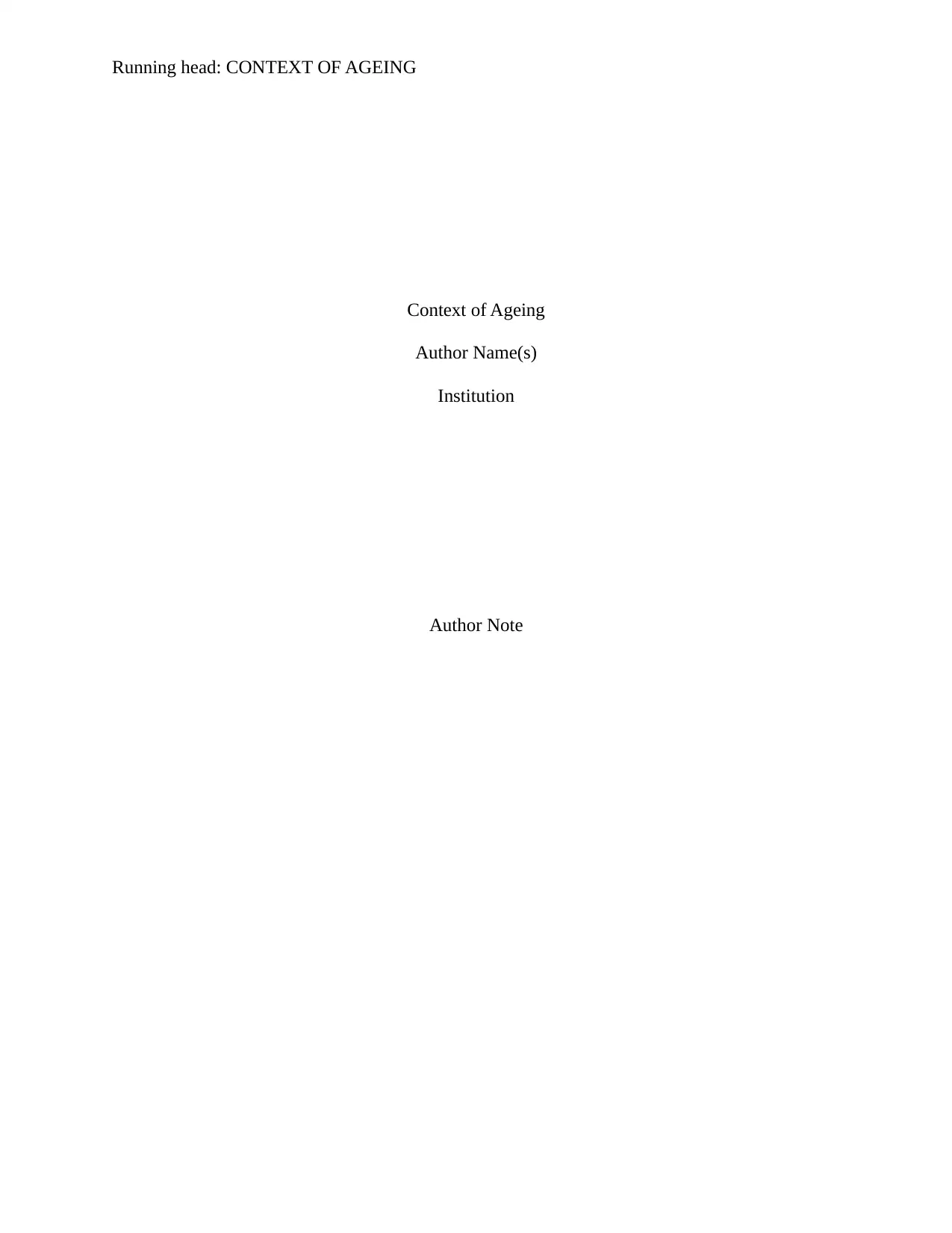
Running head: CONTEXT OF AGEING
Context of Ageing
Author Name(s)
Institution
Author Note
Context of Ageing
Author Name(s)
Institution
Author Note
Paraphrase This Document
Need a fresh take? Get an instant paraphrase of this document with our AI Paraphraser
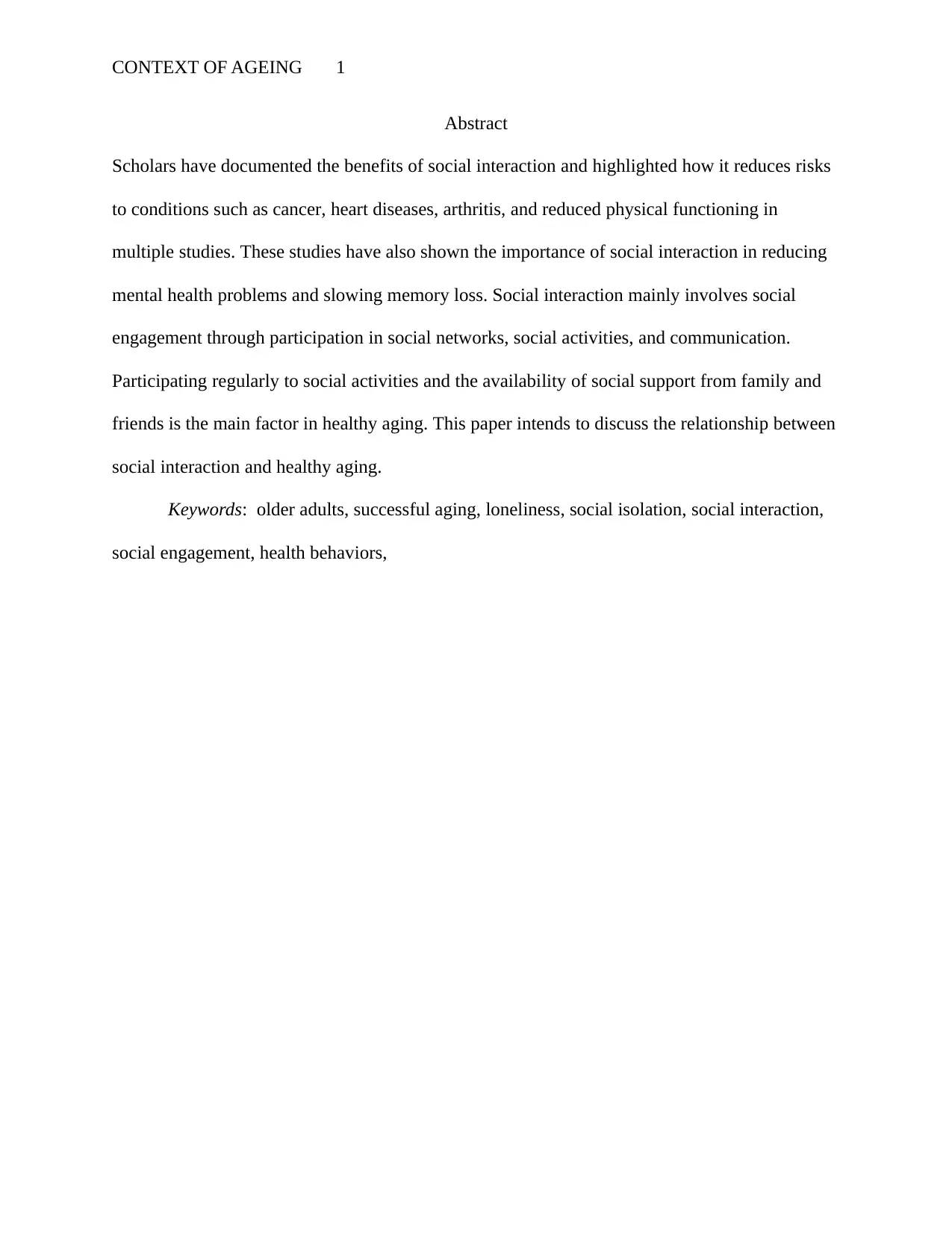
CONTEXT OF AGEING 1
Abstract
Scholars have documented the benefits of social interaction and highlighted how it reduces risks
to conditions such as cancer, heart diseases, arthritis, and reduced physical functioning in
multiple studies. These studies have also shown the importance of social interaction in reducing
mental health problems and slowing memory loss. Social interaction mainly involves social
engagement through participation in social networks, social activities, and communication.
Participating regularly to social activities and the availability of social support from family and
friends is the main factor in healthy aging. This paper intends to discuss the relationship between
social interaction and healthy aging.
Keywords: older adults, successful aging, loneliness, social isolation, social interaction,
social engagement, health behaviors,
Abstract
Scholars have documented the benefits of social interaction and highlighted how it reduces risks
to conditions such as cancer, heart diseases, arthritis, and reduced physical functioning in
multiple studies. These studies have also shown the importance of social interaction in reducing
mental health problems and slowing memory loss. Social interaction mainly involves social
engagement through participation in social networks, social activities, and communication.
Participating regularly to social activities and the availability of social support from family and
friends is the main factor in healthy aging. This paper intends to discuss the relationship between
social interaction and healthy aging.
Keywords: older adults, successful aging, loneliness, social isolation, social interaction,
social engagement, health behaviors,

CONTEXT OF AGEING 2
Context of Ageing
There is a growing recognition that social engagement is important for successful aging.
This paper will take a useful analysis of four important articles that have examined the
relationship between social interaction and successful aging. Together with other numerous
published reports, the paper will provide an empirical base supporting this relationship
disregarding the heterogeneity in measures, and methods that the scholars have used. However,
the paper will analyze the results and health outcomes that the researchers have found to exist in
the relationship. A particularly noticeable issue regards how different scholars conceptualize,
define, and assess social interaction. Despite that, there is a little consistency in that most of them
understood social interaction as an activity that mainly involves social engagement in terms of
social support, social networks, social activities, social participation, and social integration
among others.
Literature Review
Past studies have established that social relationships have a great impact on a
population’s mortality and physical health (Zhaoyang, Sliwinski, Martire, & Smyth, 2019). Poor
social connection and lack of integration create mortality risks which could be comparable to the
known risk factors like obesity. Social interaction has also been established as a universal human
need (Zhaoyang et al., 2019). The two dimensions of social interaction have been identified to
serve a structural and functional purpose (Valtorta, Kanaan, Gilbody, & Hanratty, 2016).
Structural denotes objective characteristics which can be shown with frequency and the degree of
social interaction. Functional denotes the benefit that the aged receive from social connection to
support their life (Lecce et al., 2017). Social interaction has been proven as factors for mental-,
physical-and emotional well-being(Tough, Siegrist, & Fekete, 2017). Absence of social
Context of Ageing
There is a growing recognition that social engagement is important for successful aging.
This paper will take a useful analysis of four important articles that have examined the
relationship between social interaction and successful aging. Together with other numerous
published reports, the paper will provide an empirical base supporting this relationship
disregarding the heterogeneity in measures, and methods that the scholars have used. However,
the paper will analyze the results and health outcomes that the researchers have found to exist in
the relationship. A particularly noticeable issue regards how different scholars conceptualize,
define, and assess social interaction. Despite that, there is a little consistency in that most of them
understood social interaction as an activity that mainly involves social engagement in terms of
social support, social networks, social activities, social participation, and social integration
among others.
Literature Review
Past studies have established that social relationships have a great impact on a
population’s mortality and physical health (Zhaoyang, Sliwinski, Martire, & Smyth, 2019). Poor
social connection and lack of integration create mortality risks which could be comparable to the
known risk factors like obesity. Social interaction has also been established as a universal human
need (Zhaoyang et al., 2019). The two dimensions of social interaction have been identified to
serve a structural and functional purpose (Valtorta, Kanaan, Gilbody, & Hanratty, 2016).
Structural denotes objective characteristics which can be shown with frequency and the degree of
social interaction. Functional denotes the benefit that the aged receive from social connection to
support their life (Lecce et al., 2017). Social interaction has been proven as factors for mental-,
physical-and emotional well-being(Tough, Siegrist, & Fekete, 2017). Absence of social
⊘ This is a preview!⊘
Do you want full access?
Subscribe today to unlock all pages.

Trusted by 1+ million students worldwide
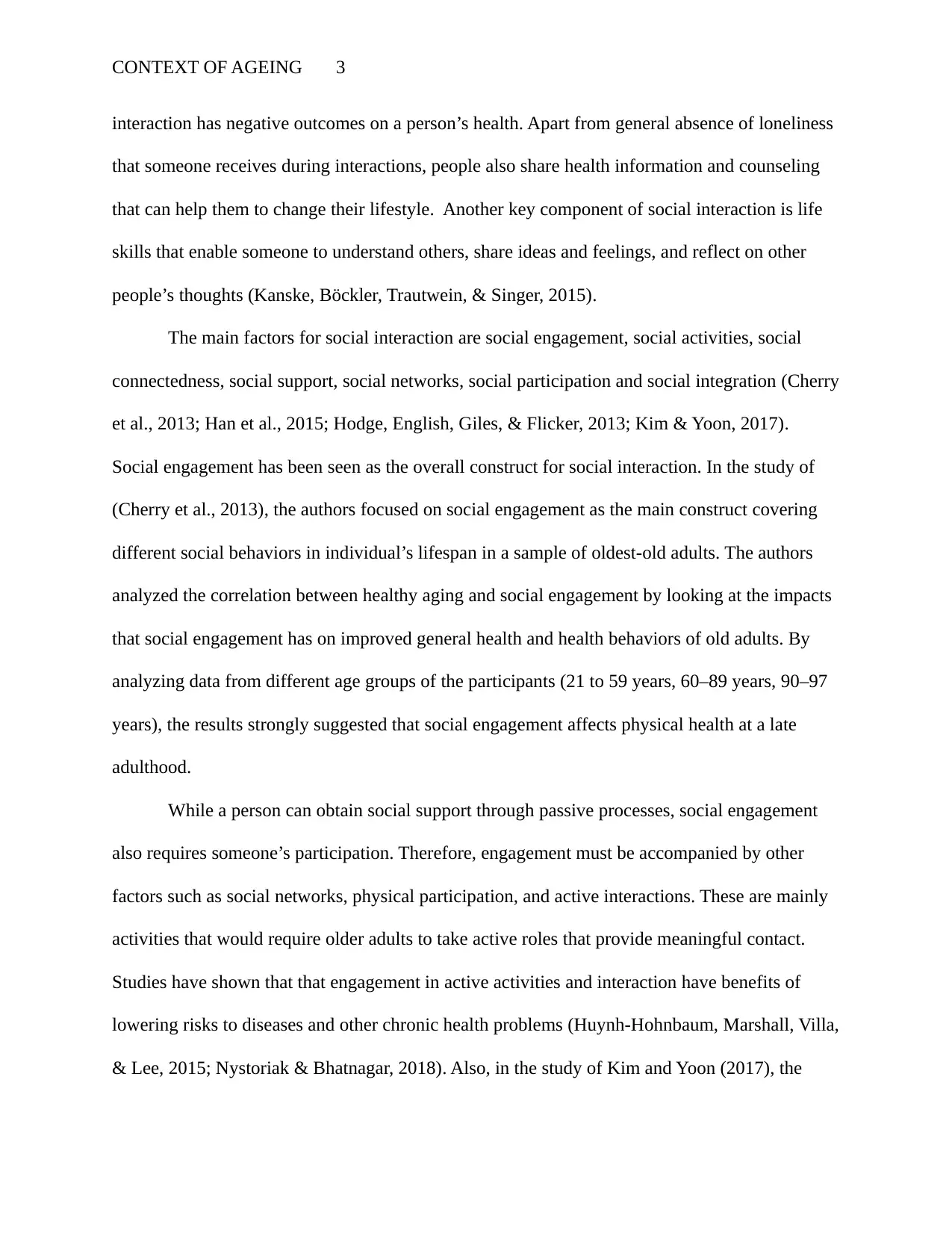
CONTEXT OF AGEING 3
interaction has negative outcomes on a person’s health. Apart from general absence of loneliness
that someone receives during interactions, people also share health information and counseling
that can help them to change their lifestyle. Another key component of social interaction is life
skills that enable someone to understand others, share ideas and feelings, and reflect on other
people’s thoughts (Kanske, Böckler, Trautwein, & Singer, 2015).
The main factors for social interaction are social engagement, social activities, social
connectedness, social support, social networks, social participation and social integration (Cherry
et al., 2013; Han et al., 2015; Hodge, English, Giles, & Flicker, 2013; Kim & Yoon, 2017).
Social engagement has been seen as the overall construct for social interaction. In the study of
(Cherry et al., 2013), the authors focused on social engagement as the main construct covering
different social behaviors in individual’s lifespan in a sample of oldest-old adults. The authors
analyzed the correlation between healthy aging and social engagement by looking at the impacts
that social engagement has on improved general health and health behaviors of old adults. By
analyzing data from different age groups of the participants (21 to 59 years, 60–89 years, 90–97
years), the results strongly suggested that social engagement affects physical health at a late
adulthood.
While a person can obtain social support through passive processes, social engagement
also requires someone’s participation. Therefore, engagement must be accompanied by other
factors such as social networks, physical participation, and active interactions. These are mainly
activities that would require older adults to take active roles that provide meaningful contact.
Studies have shown that that engagement in active activities and interaction have benefits of
lowering risks to diseases and other chronic health problems (Huynh-Hohnbaum, Marshall, Villa,
& Lee, 2015; Nystoriak & Bhatnagar, 2018). Also, in the study of Kim and Yoon (2017), the
interaction has negative outcomes on a person’s health. Apart from general absence of loneliness
that someone receives during interactions, people also share health information and counseling
that can help them to change their lifestyle. Another key component of social interaction is life
skills that enable someone to understand others, share ideas and feelings, and reflect on other
people’s thoughts (Kanske, Böckler, Trautwein, & Singer, 2015).
The main factors for social interaction are social engagement, social activities, social
connectedness, social support, social networks, social participation and social integration (Cherry
et al., 2013; Han et al., 2015; Hodge, English, Giles, & Flicker, 2013; Kim & Yoon, 2017).
Social engagement has been seen as the overall construct for social interaction. In the study of
(Cherry et al., 2013), the authors focused on social engagement as the main construct covering
different social behaviors in individual’s lifespan in a sample of oldest-old adults. The authors
analyzed the correlation between healthy aging and social engagement by looking at the impacts
that social engagement has on improved general health and health behaviors of old adults. By
analyzing data from different age groups of the participants (21 to 59 years, 60–89 years, 90–97
years), the results strongly suggested that social engagement affects physical health at a late
adulthood.
While a person can obtain social support through passive processes, social engagement
also requires someone’s participation. Therefore, engagement must be accompanied by other
factors such as social networks, physical participation, and active interactions. These are mainly
activities that would require older adults to take active roles that provide meaningful contact.
Studies have shown that that engagement in active activities and interaction have benefits of
lowering risks to diseases and other chronic health problems (Huynh-Hohnbaum, Marshall, Villa,
& Lee, 2015; Nystoriak & Bhatnagar, 2018). Also, in the study of Kim and Yoon (2017), the
Paraphrase This Document
Need a fresh take? Get an instant paraphrase of this document with our AI Paraphraser
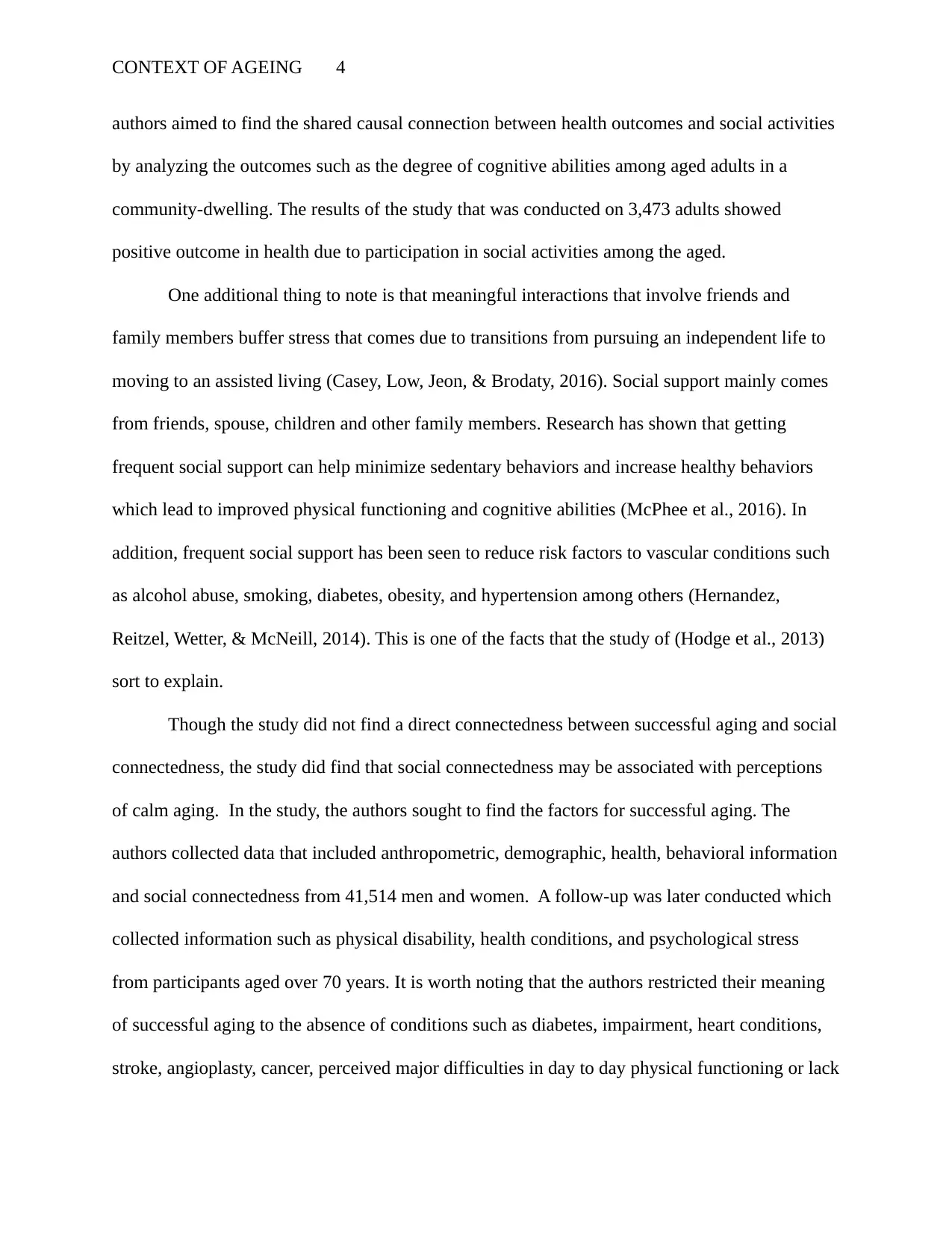
CONTEXT OF AGEING 4
authors aimed to find the shared causal connection between health outcomes and social activities
by analyzing the outcomes such as the degree of cognitive abilities among aged adults in a
community-dwelling. The results of the study that was conducted on 3,473 adults showed
positive outcome in health due to participation in social activities among the aged.
One additional thing to note is that meaningful interactions that involve friends and
family members buffer stress that comes due to transitions from pursuing an independent life to
moving to an assisted living (Casey, Low, Jeon, & Brodaty, 2016). Social support mainly comes
from friends, spouse, children and other family members. Research has shown that getting
frequent social support can help minimize sedentary behaviors and increase healthy behaviors
which lead to improved physical functioning and cognitive abilities (McPhee et al., 2016). In
addition, frequent social support has been seen to reduce risk factors to vascular conditions such
as alcohol abuse, smoking, diabetes, obesity, and hypertension among others (Hernandez,
Reitzel, Wetter, & McNeill, 2014). This is one of the facts that the study of (Hodge et al., 2013)
sort to explain.
Though the study did not find a direct connectedness between successful aging and social
connectedness, the study did find that social connectedness may be associated with perceptions
of calm aging. In the study, the authors sought to find the factors for successful aging. The
authors collected data that included anthropometric, demographic, health, behavioral information
and social connectedness from 41,514 men and women. A follow-up was later conducted which
collected information such as physical disability, health conditions, and psychological stress
from participants aged over 70 years. It is worth noting that the authors restricted their meaning
of successful aging to the absence of conditions such as diabetes, impairment, heart conditions,
stroke, angioplasty, cancer, perceived major difficulties in day to day physical functioning or lack
authors aimed to find the shared causal connection between health outcomes and social activities
by analyzing the outcomes such as the degree of cognitive abilities among aged adults in a
community-dwelling. The results of the study that was conducted on 3,473 adults showed
positive outcome in health due to participation in social activities among the aged.
One additional thing to note is that meaningful interactions that involve friends and
family members buffer stress that comes due to transitions from pursuing an independent life to
moving to an assisted living (Casey, Low, Jeon, & Brodaty, 2016). Social support mainly comes
from friends, spouse, children and other family members. Research has shown that getting
frequent social support can help minimize sedentary behaviors and increase healthy behaviors
which lead to improved physical functioning and cognitive abilities (McPhee et al., 2016). In
addition, frequent social support has been seen to reduce risk factors to vascular conditions such
as alcohol abuse, smoking, diabetes, obesity, and hypertension among others (Hernandez,
Reitzel, Wetter, & McNeill, 2014). This is one of the facts that the study of (Hodge et al., 2013)
sort to explain.
Though the study did not find a direct connectedness between successful aging and social
connectedness, the study did find that social connectedness may be associated with perceptions
of calm aging. In the study, the authors sought to find the factors for successful aging. The
authors collected data that included anthropometric, demographic, health, behavioral information
and social connectedness from 41,514 men and women. A follow-up was later conducted which
collected information such as physical disability, health conditions, and psychological stress
from participants aged over 70 years. It is worth noting that the authors restricted their meaning
of successful aging to the absence of conditions such as diabetes, impairment, heart conditions,
stroke, angioplasty, cancer, perceived major difficulties in day to day physical functioning or lack
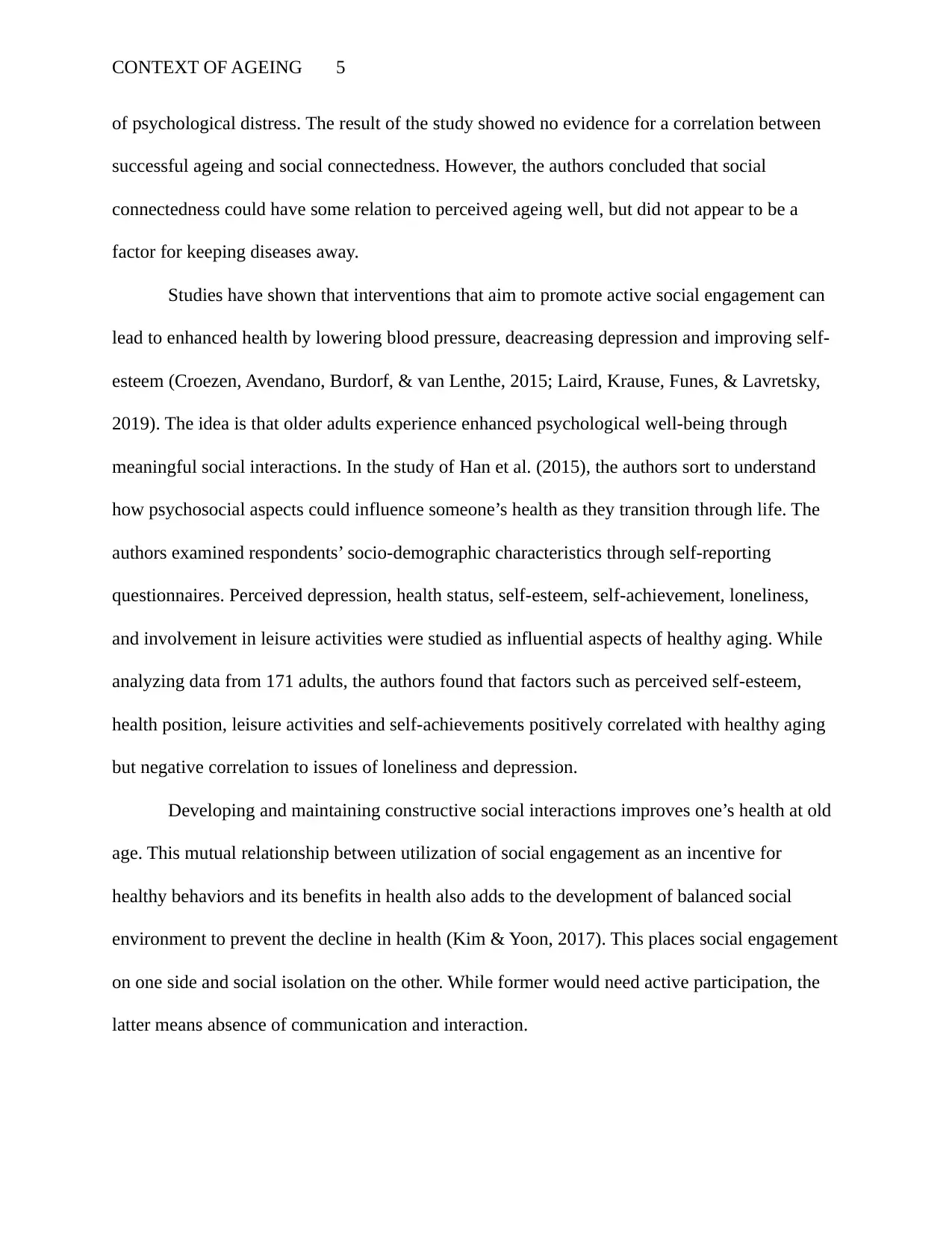
CONTEXT OF AGEING 5
of psychological distress. The result of the study showed no evidence for a correlation between
successful ageing and social connectedness. However, the authors concluded that social
connectedness could have some relation to perceived ageing well, but did not appear to be a
factor for keeping diseases away.
Studies have shown that interventions that aim to promote active social engagement can
lead to enhanced health by lowering blood pressure, deacreasing depression and improving self-
esteem (Croezen, Avendano, Burdorf, & van Lenthe, 2015; Laird, Krause, Funes, & Lavretsky,
2019). The idea is that older adults experience enhanced psychological well-being through
meaningful social interactions. In the study of Han et al. (2015), the authors sort to understand
how psychosocial aspects could influence someone’s health as they transition through life. The
authors examined respondents’ socio-demographic characteristics through self-reporting
questionnaires. Perceived depression, health status, self-esteem, self-achievement, loneliness,
and involvement in leisure activities were studied as influential aspects of healthy aging. While
analyzing data from 171 adults, the authors found that factors such as perceived self-esteem,
health position, leisure activities and self-achievements positively correlated with healthy aging
but negative correlation to issues of loneliness and depression.
Developing and maintaining constructive social interactions improves one’s health at old
age. This mutual relationship between utilization of social engagement as an incentive for
healthy behaviors and its benefits in health also adds to the development of balanced social
environment to prevent the decline in health (Kim & Yoon, 2017). This places social engagement
on one side and social isolation on the other. While former would need active participation, the
latter means absence of communication and interaction.
of psychological distress. The result of the study showed no evidence for a correlation between
successful ageing and social connectedness. However, the authors concluded that social
connectedness could have some relation to perceived ageing well, but did not appear to be a
factor for keeping diseases away.
Studies have shown that interventions that aim to promote active social engagement can
lead to enhanced health by lowering blood pressure, deacreasing depression and improving self-
esteem (Croezen, Avendano, Burdorf, & van Lenthe, 2015; Laird, Krause, Funes, & Lavretsky,
2019). The idea is that older adults experience enhanced psychological well-being through
meaningful social interactions. In the study of Han et al. (2015), the authors sort to understand
how psychosocial aspects could influence someone’s health as they transition through life. The
authors examined respondents’ socio-demographic characteristics through self-reporting
questionnaires. Perceived depression, health status, self-esteem, self-achievement, loneliness,
and involvement in leisure activities were studied as influential aspects of healthy aging. While
analyzing data from 171 adults, the authors found that factors such as perceived self-esteem,
health position, leisure activities and self-achievements positively correlated with healthy aging
but negative correlation to issues of loneliness and depression.
Developing and maintaining constructive social interactions improves one’s health at old
age. This mutual relationship between utilization of social engagement as an incentive for
healthy behaviors and its benefits in health also adds to the development of balanced social
environment to prevent the decline in health (Kim & Yoon, 2017). This places social engagement
on one side and social isolation on the other. While former would need active participation, the
latter means absence of communication and interaction.
⊘ This is a preview!⊘
Do you want full access?
Subscribe today to unlock all pages.

Trusted by 1+ million students worldwide
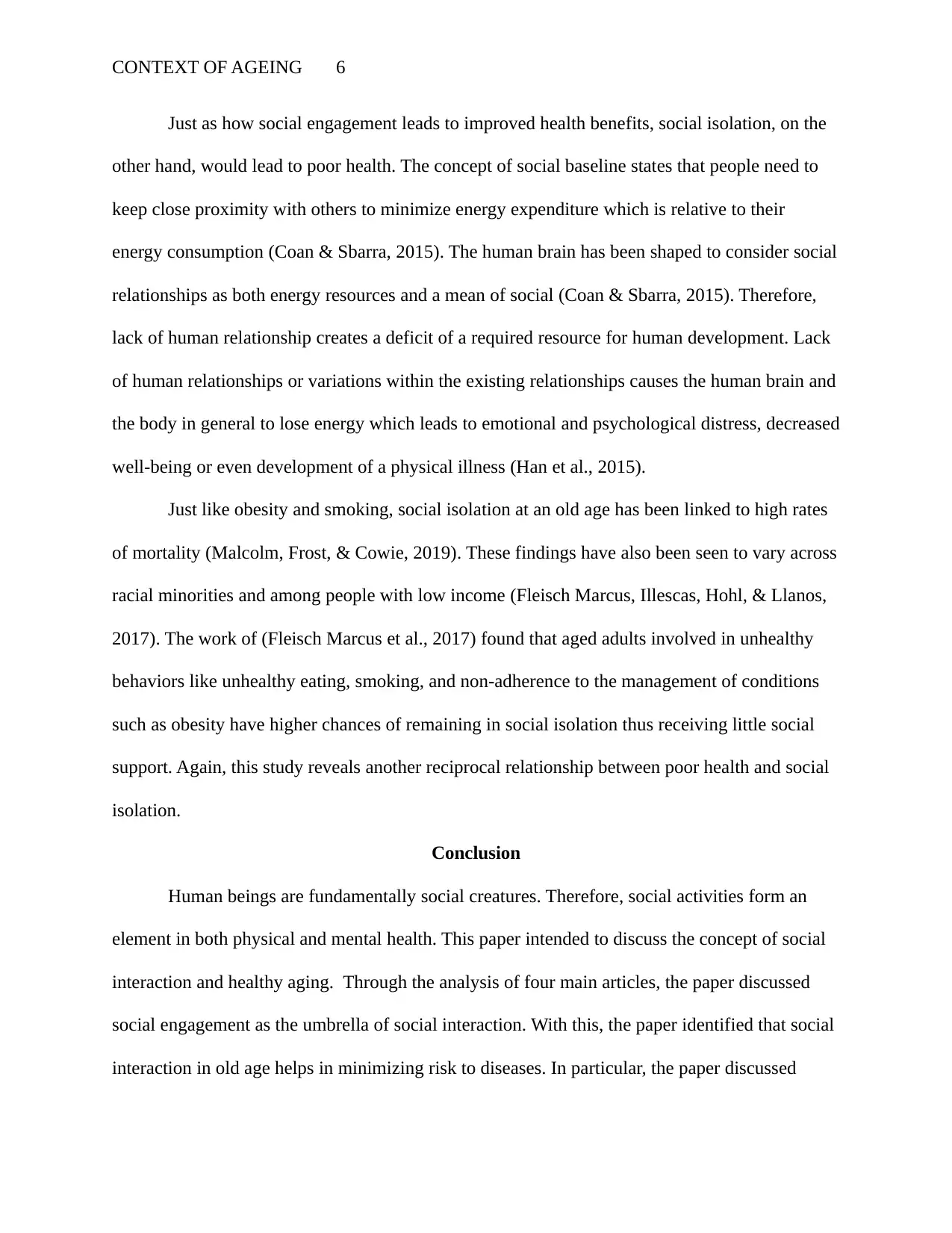
CONTEXT OF AGEING 6
Just as how social engagement leads to improved health benefits, social isolation, on the
other hand, would lead to poor health. The concept of social baseline states that people need to
keep close proximity with others to minimize energy expenditure which is relative to their
energy consumption (Coan & Sbarra, 2015). The human brain has been shaped to consider social
relationships as both energy resources and a mean of social (Coan & Sbarra, 2015). Therefore,
lack of human relationship creates a deficit of a required resource for human development. Lack
of human relationships or variations within the existing relationships causes the human brain and
the body in general to lose energy which leads to emotional and psychological distress, decreased
well-being or even development of a physical illness (Han et al., 2015).
Just like obesity and smoking, social isolation at an old age has been linked to high rates
of mortality (Malcolm, Frost, & Cowie, 2019). These findings have also been seen to vary across
racial minorities and among people with low income (Fleisch Marcus, Illescas, Hohl, & Llanos,
2017). The work of (Fleisch Marcus et al., 2017) found that aged adults involved in unhealthy
behaviors like unhealthy eating, smoking, and non-adherence to the management of conditions
such as obesity have higher chances of remaining in social isolation thus receiving little social
support. Again, this study reveals another reciprocal relationship between poor health and social
isolation.
Conclusion
Human beings are fundamentally social creatures. Therefore, social activities form an
element in both physical and mental health. This paper intended to discuss the concept of social
interaction and healthy aging. Through the analysis of four main articles, the paper discussed
social engagement as the umbrella of social interaction. With this, the paper identified that social
interaction in old age helps in minimizing risk to diseases. In particular, the paper discussed
Just as how social engagement leads to improved health benefits, social isolation, on the
other hand, would lead to poor health. The concept of social baseline states that people need to
keep close proximity with others to minimize energy expenditure which is relative to their
energy consumption (Coan & Sbarra, 2015). The human brain has been shaped to consider social
relationships as both energy resources and a mean of social (Coan & Sbarra, 2015). Therefore,
lack of human relationship creates a deficit of a required resource for human development. Lack
of human relationships or variations within the existing relationships causes the human brain and
the body in general to lose energy which leads to emotional and psychological distress, decreased
well-being or even development of a physical illness (Han et al., 2015).
Just like obesity and smoking, social isolation at an old age has been linked to high rates
of mortality (Malcolm, Frost, & Cowie, 2019). These findings have also been seen to vary across
racial minorities and among people with low income (Fleisch Marcus, Illescas, Hohl, & Llanos,
2017). The work of (Fleisch Marcus et al., 2017) found that aged adults involved in unhealthy
behaviors like unhealthy eating, smoking, and non-adherence to the management of conditions
such as obesity have higher chances of remaining in social isolation thus receiving little social
support. Again, this study reveals another reciprocal relationship between poor health and social
isolation.
Conclusion
Human beings are fundamentally social creatures. Therefore, social activities form an
element in both physical and mental health. This paper intended to discuss the concept of social
interaction and healthy aging. Through the analysis of four main articles, the paper discussed
social engagement as the umbrella of social interaction. With this, the paper identified that social
interaction in old age helps in minimizing risk to diseases. In particular, the paper discussed
Paraphrase This Document
Need a fresh take? Get an instant paraphrase of this document with our AI Paraphraser

CONTEXT OF AGEING 7
social engagement in terms of active interaction, communication, and participation. In this way
social interaction was seen to reduce health risks such as obesity, smoking, depression, and stress
among others.
social engagement in terms of active interaction, communication, and participation. In this way
social interaction was seen to reduce health risks such as obesity, smoking, depression, and stress
among others.
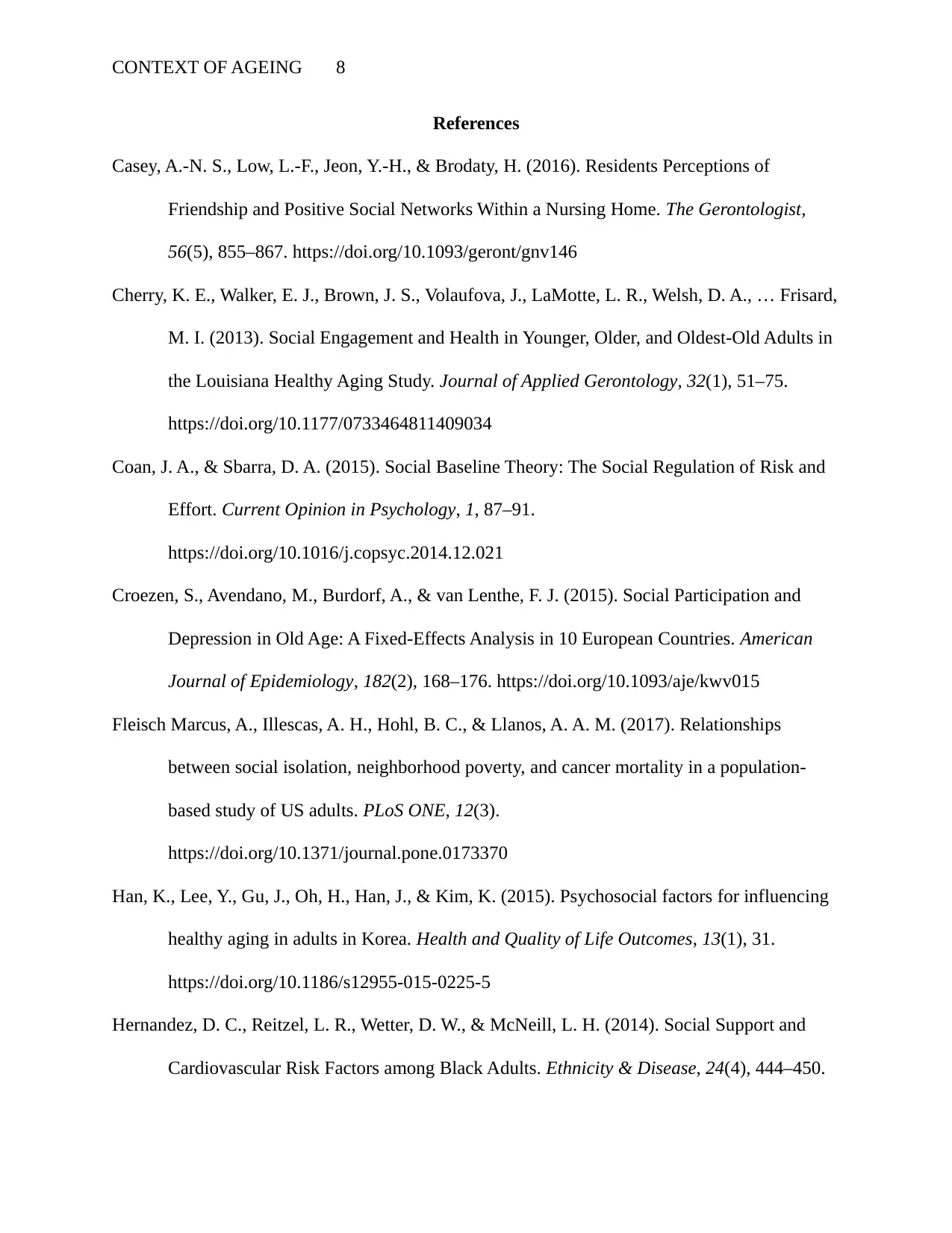
CONTEXT OF AGEING 8
References
Casey, A.-N. S., Low, L.-F., Jeon, Y.-H., & Brodaty, H. (2016). Residents Perceptions of
Friendship and Positive Social Networks Within a Nursing Home. The Gerontologist,
56(5), 855–867. https://doi.org/10.1093/geront/gnv146
Cherry, K. E., Walker, E. J., Brown, J. S., Volaufova, J., LaMotte, L. R., Welsh, D. A., … Frisard,
M. I. (2013). Social Engagement and Health in Younger, Older, and Oldest-Old Adults in
the Louisiana Healthy Aging Study. Journal of Applied Gerontology, 32(1), 51–75.
https://doi.org/10.1177/0733464811409034
Coan, J. A., & Sbarra, D. A. (2015). Social Baseline Theory: The Social Regulation of Risk and
Effort. Current Opinion in Psychology, 1, 87–91.
https://doi.org/10.1016/j.copsyc.2014.12.021
Croezen, S., Avendano, M., Burdorf, A., & van Lenthe, F. J. (2015). Social Participation and
Depression in Old Age: A Fixed-Effects Analysis in 10 European Countries. American
Journal of Epidemiology, 182(2), 168–176. https://doi.org/10.1093/aje/kwv015
Fleisch Marcus, A., Illescas, A. H., Hohl, B. C., & Llanos, A. A. M. (2017). Relationships
between social isolation, neighborhood poverty, and cancer mortality in a population-
based study of US adults. PLoS ONE, 12(3).
https://doi.org/10.1371/journal.pone.0173370
Han, K., Lee, Y., Gu, J., Oh, H., Han, J., & Kim, K. (2015). Psychosocial factors for influencing
healthy aging in adults in Korea. Health and Quality of Life Outcomes, 13(1), 31.
https://doi.org/10.1186/s12955-015-0225-5
Hernandez, D. C., Reitzel, L. R., Wetter, D. W., & McNeill, L. H. (2014). Social Support and
Cardiovascular Risk Factors among Black Adults. Ethnicity & Disease, 24(4), 444–450.
References
Casey, A.-N. S., Low, L.-F., Jeon, Y.-H., & Brodaty, H. (2016). Residents Perceptions of
Friendship and Positive Social Networks Within a Nursing Home. The Gerontologist,
56(5), 855–867. https://doi.org/10.1093/geront/gnv146
Cherry, K. E., Walker, E. J., Brown, J. S., Volaufova, J., LaMotte, L. R., Welsh, D. A., … Frisard,
M. I. (2013). Social Engagement and Health in Younger, Older, and Oldest-Old Adults in
the Louisiana Healthy Aging Study. Journal of Applied Gerontology, 32(1), 51–75.
https://doi.org/10.1177/0733464811409034
Coan, J. A., & Sbarra, D. A. (2015). Social Baseline Theory: The Social Regulation of Risk and
Effort. Current Opinion in Psychology, 1, 87–91.
https://doi.org/10.1016/j.copsyc.2014.12.021
Croezen, S., Avendano, M., Burdorf, A., & van Lenthe, F. J. (2015). Social Participation and
Depression in Old Age: A Fixed-Effects Analysis in 10 European Countries. American
Journal of Epidemiology, 182(2), 168–176. https://doi.org/10.1093/aje/kwv015
Fleisch Marcus, A., Illescas, A. H., Hohl, B. C., & Llanos, A. A. M. (2017). Relationships
between social isolation, neighborhood poverty, and cancer mortality in a population-
based study of US adults. PLoS ONE, 12(3).
https://doi.org/10.1371/journal.pone.0173370
Han, K., Lee, Y., Gu, J., Oh, H., Han, J., & Kim, K. (2015). Psychosocial factors for influencing
healthy aging in adults in Korea. Health and Quality of Life Outcomes, 13(1), 31.
https://doi.org/10.1186/s12955-015-0225-5
Hernandez, D. C., Reitzel, L. R., Wetter, D. W., & McNeill, L. H. (2014). Social Support and
Cardiovascular Risk Factors among Black Adults. Ethnicity & Disease, 24(4), 444–450.
⊘ This is a preview!⊘
Do you want full access?
Subscribe today to unlock all pages.

Trusted by 1+ million students worldwide

CONTEXT OF AGEING 9
Hodge, A. M., English, D. R., Giles, G. G., & Flicker, L. (2013). Social connectedness and
predictors of successful ageing. Maturitas, 75(4), 361–366.
https://doi.org/10.1016/j.maturitas.2013.05.002
Holt-Lunstad, J., Smith, T. B., Baker, M., Harris, T., & Stephenson, D. (2015). Loneliness and
Social Isolation as Risk Factors for Mortality: A Meta-Analytic Review. Perspectives on
Psychological Science, 10(2), 227–237. https://doi.org/10.1177/1745691614568352
Huynh-Hohnbaum, A.-L. T., Marshall, L., Villa, V. M., & Lee, G. (2015). Self-Management of
Heart Disease in Older Adults. Home Health Care Services Quarterly, 34(0), 159–172.
https://doi.org/10.1080/01621424.2015.1092909
Kanske, P., Böckler, A., Trautwein, F.-M., & Singer, T. (2015). Dissecting the social brain:
Introducing the EmpaToM to reveal distinct neural networks and brain–behavior relations
for empathy and Theory of Mind. NeuroImage, 122, 6–19.
https://doi.org/10.1016/j.neuroimage.2015.07.082
Kim, D. E., & Yoon, J. Y. (2017). The Reciprocal Causal Relationship between Social Activities
and Health with Reference to the Cognitive Function Level among Community-dwelling
Older Adults: A Cross-Lagged Panel Analysis. Journal of Korean Academy of
Community Health Nursing, 28(1), 13. https://doi.org/10.12799/jkachn.2017.28.1.13
Laird, K. T., Krause, B., Funes, C., & Lavretsky, H. (2019). Psychobiological factors of
resilience and depression in late life. Translational Psychiatry, 9(1), 1–18.
https://doi.org/10.1038/s41398-019-0424-7
Lecce, S., Ceccato, I., Bianco, F., Rosi, A., Bottiroli, S., & Cavallini, E. (2017). Theory of Mind
and social relationships in older adults: The role of social motivation. Aging & Mental
Health, 21(3), 253–258. https://doi.org/10.1080/13607863.2015.1114586
Hodge, A. M., English, D. R., Giles, G. G., & Flicker, L. (2013). Social connectedness and
predictors of successful ageing. Maturitas, 75(4), 361–366.
https://doi.org/10.1016/j.maturitas.2013.05.002
Holt-Lunstad, J., Smith, T. B., Baker, M., Harris, T., & Stephenson, D. (2015). Loneliness and
Social Isolation as Risk Factors for Mortality: A Meta-Analytic Review. Perspectives on
Psychological Science, 10(2), 227–237. https://doi.org/10.1177/1745691614568352
Huynh-Hohnbaum, A.-L. T., Marshall, L., Villa, V. M., & Lee, G. (2015). Self-Management of
Heart Disease in Older Adults. Home Health Care Services Quarterly, 34(0), 159–172.
https://doi.org/10.1080/01621424.2015.1092909
Kanske, P., Böckler, A., Trautwein, F.-M., & Singer, T. (2015). Dissecting the social brain:
Introducing the EmpaToM to reveal distinct neural networks and brain–behavior relations
for empathy and Theory of Mind. NeuroImage, 122, 6–19.
https://doi.org/10.1016/j.neuroimage.2015.07.082
Kim, D. E., & Yoon, J. Y. (2017). The Reciprocal Causal Relationship between Social Activities
and Health with Reference to the Cognitive Function Level among Community-dwelling
Older Adults: A Cross-Lagged Panel Analysis. Journal of Korean Academy of
Community Health Nursing, 28(1), 13. https://doi.org/10.12799/jkachn.2017.28.1.13
Laird, K. T., Krause, B., Funes, C., & Lavretsky, H. (2019). Psychobiological factors of
resilience and depression in late life. Translational Psychiatry, 9(1), 1–18.
https://doi.org/10.1038/s41398-019-0424-7
Lecce, S., Ceccato, I., Bianco, F., Rosi, A., Bottiroli, S., & Cavallini, E. (2017). Theory of Mind
and social relationships in older adults: The role of social motivation. Aging & Mental
Health, 21(3), 253–258. https://doi.org/10.1080/13607863.2015.1114586
Paraphrase This Document
Need a fresh take? Get an instant paraphrase of this document with our AI Paraphraser
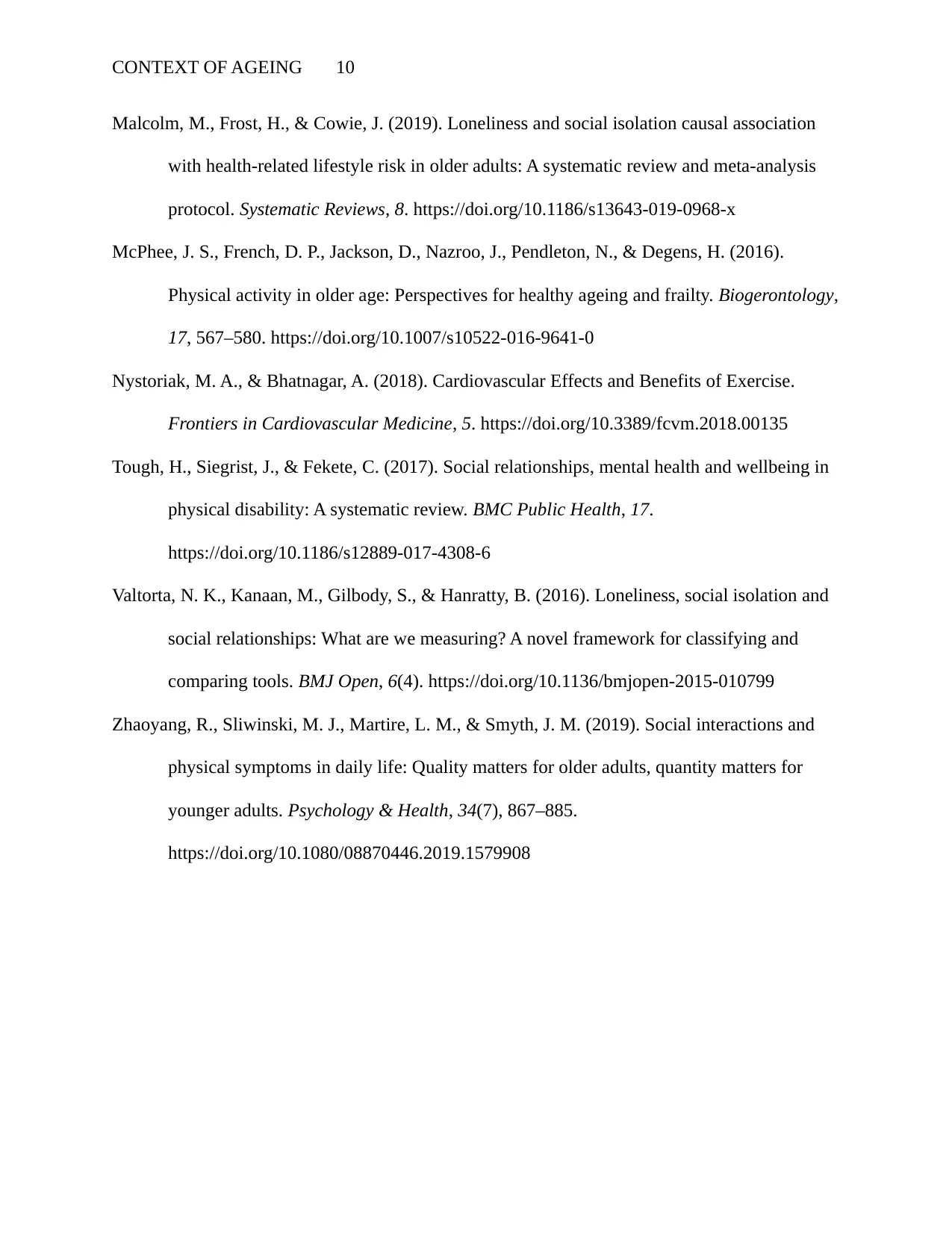
CONTEXT OF AGEING 10
Malcolm, M., Frost, H., & Cowie, J. (2019). Loneliness and social isolation causal association
with health-related lifestyle risk in older adults: A systematic review and meta-analysis
protocol. Systematic Reviews, 8. https://doi.org/10.1186/s13643-019-0968-x
McPhee, J. S., French, D. P., Jackson, D., Nazroo, J., Pendleton, N., & Degens, H. (2016).
Physical activity in older age: Perspectives for healthy ageing and frailty. Biogerontology,
17, 567–580. https://doi.org/10.1007/s10522-016-9641-0
Nystoriak, M. A., & Bhatnagar, A. (2018). Cardiovascular Effects and Benefits of Exercise.
Frontiers in Cardiovascular Medicine, 5. https://doi.org/10.3389/fcvm.2018.00135
Tough, H., Siegrist, J., & Fekete, C. (2017). Social relationships, mental health and wellbeing in
physical disability: A systematic review. BMC Public Health, 17.
https://doi.org/10.1186/s12889-017-4308-6
Valtorta, N. K., Kanaan, M., Gilbody, S., & Hanratty, B. (2016). Loneliness, social isolation and
social relationships: What are we measuring? A novel framework for classifying and
comparing tools. BMJ Open, 6(4). https://doi.org/10.1136/bmjopen-2015-010799
Zhaoyang, R., Sliwinski, M. J., Martire, L. M., & Smyth, J. M. (2019). Social interactions and
physical symptoms in daily life: Quality matters for older adults, quantity matters for
younger adults. Psychology & Health, 34(7), 867–885.
https://doi.org/10.1080/08870446.2019.1579908
Malcolm, M., Frost, H., & Cowie, J. (2019). Loneliness and social isolation causal association
with health-related lifestyle risk in older adults: A systematic review and meta-analysis
protocol. Systematic Reviews, 8. https://doi.org/10.1186/s13643-019-0968-x
McPhee, J. S., French, D. P., Jackson, D., Nazroo, J., Pendleton, N., & Degens, H. (2016).
Physical activity in older age: Perspectives for healthy ageing and frailty. Biogerontology,
17, 567–580. https://doi.org/10.1007/s10522-016-9641-0
Nystoriak, M. A., & Bhatnagar, A. (2018). Cardiovascular Effects and Benefits of Exercise.
Frontiers in Cardiovascular Medicine, 5. https://doi.org/10.3389/fcvm.2018.00135
Tough, H., Siegrist, J., & Fekete, C. (2017). Social relationships, mental health and wellbeing in
physical disability: A systematic review. BMC Public Health, 17.
https://doi.org/10.1186/s12889-017-4308-6
Valtorta, N. K., Kanaan, M., Gilbody, S., & Hanratty, B. (2016). Loneliness, social isolation and
social relationships: What are we measuring? A novel framework for classifying and
comparing tools. BMJ Open, 6(4). https://doi.org/10.1136/bmjopen-2015-010799
Zhaoyang, R., Sliwinski, M. J., Martire, L. M., & Smyth, J. M. (2019). Social interactions and
physical symptoms in daily life: Quality matters for older adults, quantity matters for
younger adults. Psychology & Health, 34(7), 867–885.
https://doi.org/10.1080/08870446.2019.1579908
1 out of 11
Related Documents
Your All-in-One AI-Powered Toolkit for Academic Success.
+13062052269
info@desklib.com
Available 24*7 on WhatsApp / Email
![[object Object]](/_next/static/media/star-bottom.7253800d.svg)
Unlock your academic potential
Copyright © 2020–2025 A2Z Services. All Rights Reserved. Developed and managed by ZUCOL.





